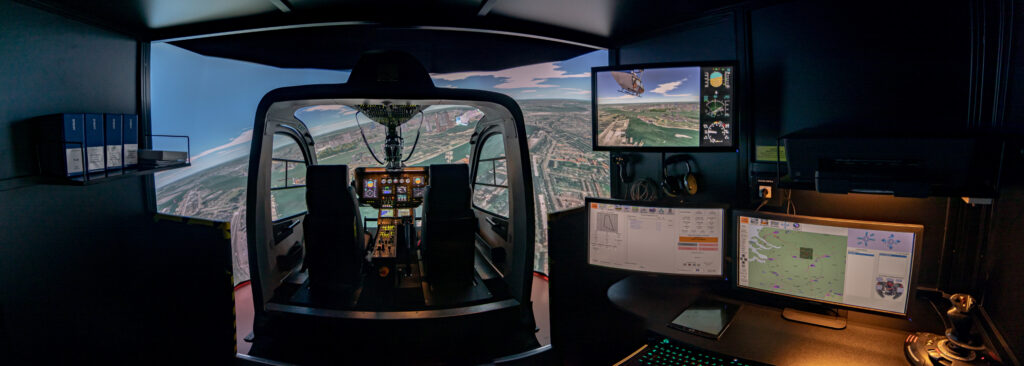The safest way to fly helicopters is to learn all the difficult procedures on the ground. What to do in dangerous conditions, how to handle a malfunction or prepare for any emergency that would be impossible to train for in a real helicopter. A helicopter simulator is also cost effective and sustainable.
In 2020, HeliCentre was the first helicopter company in the Netherlands to install an EC135 FTD3/FNPT3 simulator. A decision stimulated by their client, the Dutch Aviation Police. It enabled HeliCentre to expand their scope of education and what they could offer to both new and experienced pilots. Jeroen Peddemors, owner and CEO of HeliCentre explains the process and advantages.
Working together with the Dutch Aviation Police
“We have been training the Dutch Aviation Police since 2018. The question arose that they would like more training possibilities for their crew. We sat together with them to look at various scenarios. We decided to invest in a large EC 135 P2+ simulator, based on the Airbus H135. It was at Level 2 FTD, which, working with the manufacturer, we upgraded to Level 3 FTD. This allowed us to do the usual checks with the police crew and all the yearly recurring training. It was a big step, but it has made us more durable for the future. Synthetic training is the helicopter training of the future.”
The Dutch police contract set the wheels and calculations in motion. The choice of simulator is a logical one, well-purposed for police, military and medical services. Also for offshore, wind turbine and aerial work. The most important point: you’re at the level where flying on the simulator counts as if you’re flying for real. And it’s also certified as FNPT III.
“FNPT III means that it’s a procedure trainer, and can be used by pilots flying different types of helicopters. In that case it is really about the procedures that we’re going to train. For example, IFR or multi-crew training.”
Popular with helicopter operators
The simulator has proven very popular with helicopter operators to carry out parts of their training. Clients come from Europe and beyond, for example, Petroleum Air Services, based in Port Said, Egypt. PBN (performance-based navigation) offering greater navigational accuracy is another good example of attracting clients to HeliCentre.
“We have a special syllabus just to do the PBN training. If a pilot already has an instrument rating but just needs their PBN added to it, we can do that at our ATO flight school with our simulator.”
Pilots need to maintain their career path by completing ratings, learning new skills and compulsory yearly training. When a client books a simulator, they come either with or without their own instructor. If they bring their own instructor, is it difficult for them to work with the simulator?
Dry or wet lease?
“We have two flavours, “dry lease” or “wet lease”. The dry lease means that you just rent the simulator and your instructor will get the IOS instructor training course to learn how to use the simulator. They then rent it per hour, in two-hour blocks, depending on how many hours they require. Therefore, the operator can train their own crew, just using the simulator.
On the other hand, we have the wet lease, which includes the instructor and a complete syllabus. Approved training whether it be multi-crew, course work, an IFR course type rating, EC135, whatever the client requires. It can also be a combination.”
There are a number of other helicopter operators in Europe who have the latest in helicopter simulation, based on a virtual reality motion platform. How does that compare? Or is it completely different?
Following the latest developments
“We’re in to new technology and we continue to follow the latest developments. The virtual reality systems are great today for single pilot operations. However, for multi-crew or operating with two pilots it’s easier to be in a non-VR simulator. The interaction between the pilots is better. But, the technology is developing very quickly. We’ll see where it takes us.”
Whether you’re choosing simulators or real helicopters, there are always many practical issues to take into consideration. For example, HeliCentre is based in Lelystad near Amsterdam Airport Schiphol. What can customers expect, in terms of facilities and accommodation?
“We have many special deals with hotels in the neighbourhood. Sometimes, clients prefer to stay in Amsterdam, which isn’t too far away. We can help them with choosing a hotel there too and provide daily transport to and from Lelystad Airport. We have plenty of amenities and facilities to keep our clients occupied when they’re not using the simulator or flying.”
Improving safety in the air
The costs of training on a simulator are much lower than flying in a real helicopter, but that is not the reason to use it. It’s mostly about the situations you cannot and absolutely do not want to experience when you’re in the air. Improving a pilot’s reaction time and thereby safety in the air. And it’s about providing consistency training multiple pilots.
“The simulator is certainly very useful for proficiency checks to stay current and valid to fly. We can also update and upgrade it, as soon as new software is available. Another thing is that you can fly the simulator whatever the weather is outside, whatever time of day it is, whatever the season. 365 days of the year, 24/7.
HeliCentre is a founding member of the Leading Helicopter Academies (LHA). The first European network of helicopters companies, committed to raising flying standards by combining their strengths and industry knowledge.
